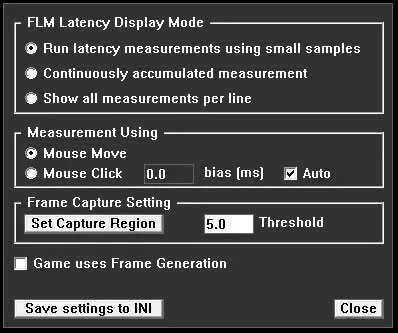AMD just released a free tool that all PC gamers should try
AMD has just introduced Frame Latency Meter (FLM), an open source Windows utility designed to measure game response times based on mouse movements. FLM can accurately record the time it takes for mouse movement to reach a new frame on the screen, thereby providing detailed information about system performance.
This tool is specifically aimed at hardcore gamers, power users, and game developers interested in optimizing system-wide latency or reducing input lag. If you're unfamiliar with frame latency measurements, they are commonly used online to estimate input latency by measuring node-to-pixel latency.
This utility doesn't require any special equipment, and works with any AMD, Nvidia, or Intel GPU that supports DirectX 11 or later. To collect data, AMD GPUs use the Advanced Media Framework (AMF) codec, while other GPUs use the DirectX Graphics Infrastructure (DXGI) codec. FLM can generate detailed latency and frame rate statistics efficiently, and supports export to CSV files for more in-depth data analysis.

FLM measures latency by continuously capturing frames and comparing each frame to the previous frame in the selected region. The application then generates a mouse movement event using standard Windows functionality and waits for the frame content to change. The time between mouse movement and the detected frame change is recorded as a delay.
To achieve clearer values, 16 latency measurements are averaged per row, but more measurements can also be averaged for greater precision. Because the FLM does not require a muzzle flash to measure latency, it allows for fast, repeatable measurements over long periods of time, allowing the application to automatically collect unlimited samples for precision. higher body.
The software also offers some level of customization, allowing users to measure latency based on mouse movements or clicks. Users can specify the frame capture area and even choose between small samples, continuous accumulation, or constant gauges for measurement. FLM also supports framing technology, although it's unclear whether the application is compatible with all games that support the latest FSR 3 or DLSS 3.
FLM is currently available as a free download for Windows 10 and 11 users via GPU Open or the official GitHub repository.
 8 rules to break when taking photos on your phone
8 rules to break when taking photos on your phone Why not choose Adobe Creative Cloud in 2024?
Why not choose Adobe Creative Cloud in 2024? Mistral announces Large 2: flagship LLM with 123 billion parameters
Mistral announces Large 2: flagship LLM with 123 billion parameters 5 reasons to upgrade to 14th generation Intel CPU
5 reasons to upgrade to 14th generation Intel CPU Instructions for changing the Google logo on the New Tab page
Instructions for changing the Google logo on the New Tab page The next global computer crash is predicted to occur in 2038
The next global computer crash is predicted to occur in 2038